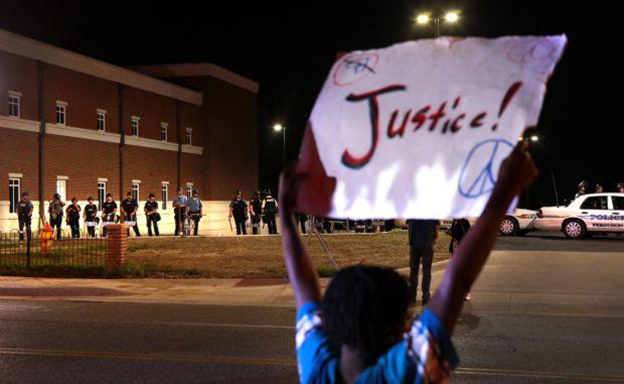First Night Of Calm In Racially Charged Ferguson
First night of peace in Ferguson
NEW DELHI: Thursday night was the first night of relative calm in the St. Louis suburb of Ferguson, Missouri, where 11 days of protests have refocused attention on racial discrimination and police brutality, following the police shooting of 18 year old African-American Michael Brown. The peace coincides with a Grand Jury beginning investigation into whether the office who killed Brown should be criminally charged.
18 year old Brown was reportedly walking, unarmed, from a convenience store to his grandmother’s apartment in Ferguson, when a police officer shot and killed him. Eyewitness accounts suggest that Brown was cooperative, raising his arms when the officer shot at him multiple times. The police version notes a struggle, saying that Brown attempted to get hold of the officer’s gun. An autopsy of Brown, released on Monday, notes that the young man was shot six times, including twice in the head.
The incident brought thousands on to the streets to ask for justice, with personal accounts of people feeling targeted by the police on the basis of their race began emerging. The police’s handling of protests added insult to injury, with the use of tear gas and rubber bullets leading to the suppression of what began as a peaceful demonstration of discontent.
Brown’s death , seems to be a trigger, representing years of frustration and marginalisation. Ferguson is a city of 21,000 people - 67 percent of whom are black. However, 94 percent of the police force, and most prominent figures in local government, including the mayor, are white.
With Ferguson coming to represent a “war zone,” pitting the police against local resident, the imposition of curfews, and the moving in of the National Guard, issues of racial discrimination, police brutality, and civil rights are once again centrestage in a deeply unequal United States.
The situation prompted a statement from US President Barack Obama, who on Monday, whilst acknowledging deep racial divisions in American society, appealed for calm. “In too many communities around the country, a gulf of mistrust exists between local residents and law enforcement… In too many communities, too many young men of color are left behind and seen only as objects of fear,” Obama said, adding that whilst progress has been made, “we have not made enough progress.”
Whilst stating that there was “no excuse for excessive force by police or any action that denies people the right to protest peacefully,” Obama said, “I understand the passions and the anger that arise over the death of Michael Brown, [however] giving in to that anger by looting or carrying guns and even attacking the police only serves to raise tensions and stir chaos.”
The shooting of Michael Brown is being compared to the shooting of 17-year old unarmed Trayvon Martin, who was killed by a neighbourhood watch captain. The shooter was eventually acquitted of murder in a racially charged case.
Other parallels have been drawn as well. The killing of 17-year old Jordan Davis, who was, along with his friends, shot at by a man for playing “loud music.” The jury convicted the shooter on four counts, but not on the count of murder, with many attributing the verdict to a racial context -- the shooter being white and the teenagers, including Davis who died, being black.
The most apparent parallel however, are the Los Angeles riots of 1992 -- where the trigger was the brutal police beating of Rodney King, which was videotaped and widely covered but ended in the acquittal of the officers concerned. The Ferguson protests, much like the LA riots of 1992, may have been a reaction to an immediate trigger, but are located in a far broader context of marginalisation and discrimination.





